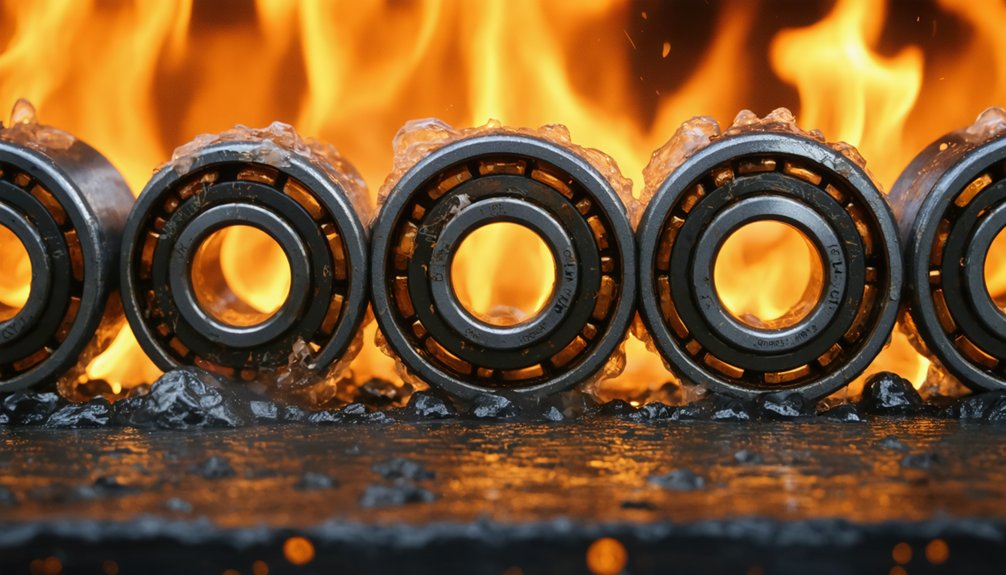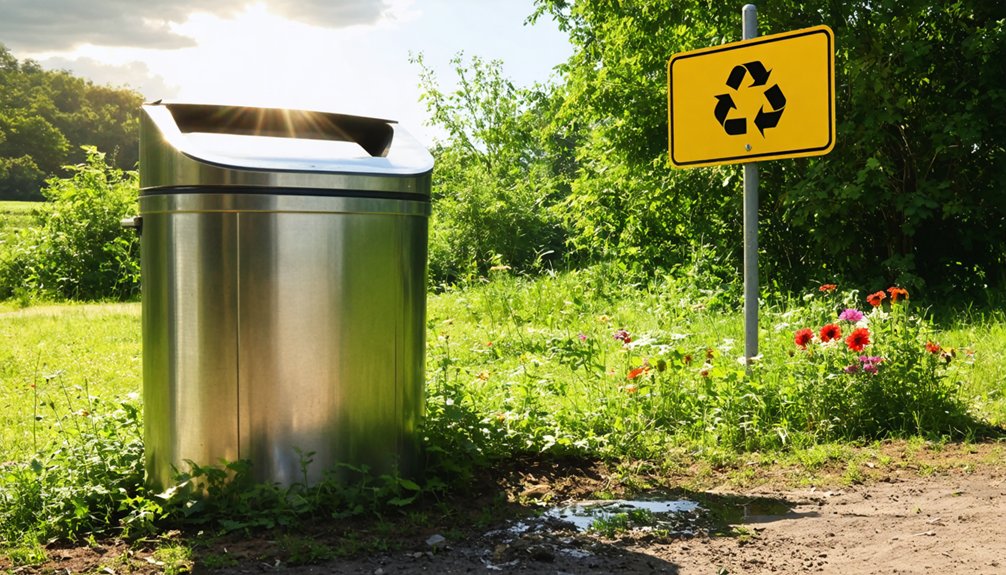How Industrial Bearings Survive Extreme Heat
Industrial bearings often encounter extreme heat, and their survival relies on several key factors functioning together. Specialized materials, advanced lubricants, and strategic design considerations significantly influence the difference between continued operation and catastrophic failure. Modern bearings don’t simply endure these harsh conditions by chance; they reflect decades of engineering innovation.
What specific technologies help these vital components maintain performance under intense heat?
Key Technologies for Bearing Durability
- High-Temperature Materials: Bearings made from heat-resistant alloys and ceramics withstand elevated temperatures without losing their mechanical integrity.
- Advanced Lubricants: Specialized Armor Lubricants provide superior performance in high-heat environments. They minimize friction and wear, ensuring smooth operation even under duress.
- Innovative Designs: Engineers design bearings with features like optimized geometries and improved sealing to enhance heat dissipation and maintain stability.
Real-World Applications
In steel manufacturing, bearings operate in environments exceeding 400°F. Utilizing high-performance materials and Armor Lubricants, these bearings maintain optimal performance, preventing costly downtimes and ensuring continuous operation.
In the automotive industry, bearings endure extreme conditions in engines. The integration of advanced lubricants and robust materials allows them to function flawlessly, even at high temperatures.
Understanding the combination of materials, lubricants, and designs that enable bearings to survive extreme heat showcases the significance of engineering advancements in industrial applications.
High-Temperature Resistant Materials for Bearing Construction
Choosing High-Temperature Materials for Bearings
Operating in high-temperature environments requires careful material selection for bearing construction. The right choices guarantee operational reliability in extreme heat conditions.
High-temperature bearings utilize specialized alloys and ceramics designed to endure temperatures above 350°C while maintaining structural integrity.
Material Options for High-Temperature Bearings
- Stainless Steel: Offers superior resistance to thermal stress.
- Titanium Alloys: Provide enhanced durability under extreme conditions.
- Ceramic Materials: Deliver exceptional performance where metal options may fail.
These materials significantly extend bearing life in high-heat environments.
Custom Solutions for Precise Requirements
Engineered solutions often feature tailored hardness ratings specifically designed to meet operational needs. This customization prevents premature wear, ensuring that bearings perform optimally under thermal stress.
When selecting bearings for high-temperature applications, prioritize material choice. It directly influences longevity and performance reliability.
For demanding situations, consider Armor Lubricants products, which excel in high-temperature applications, delivering outstanding durability and service life.
Advanced Lubricant Technologies for Extreme Heat Conditions
Specialized Thermal Greases for High-Temperature Applications
When temperatures exceed 300°F in industrial bearing applications, turn to specialized thermal greases to maintain lubrication integrity.
Conventional lubricants often falter under such conditions, making dry film alternatives an excellent choice. These alternatives provide a solid-state solution that remains stable and minimizes breakdown or evaporation.
Exceptional Solutions for Extreme Heat
Consider options like ceramic composites, which deliver outstanding thermal stability and wear protection.
These materials significantly extend the operational life of your bearings in the most demanding high-temperature environments.
Choosing Quality Products: Key Considerations
When selecting a lubricant, keep the following factors in mind:
- Thermal Stability: Ensures performance at elevated temperatures.
- Wear Protection: Reduces friction and prolongs component life.
- Resistance to Evaporation: Maintains effective lubrication over time.
- Solid-State Solutions: Provides reliability even in the harshest conditions.
For optimal results, trust only Armor Lubricants to meet the demands of extreme heat exposure.
Specialized Thermal Greases
Revolutionizing Bearing Performance with Specialized Thermal Greases
Standard lubricants often fail in extreme conditions. Specialized thermal greases have emerged as a solution for enhancing bearing performance in high-heat environments.
When selecting lubricants for high-temperature bearings, focus on formulations that maintain integrity above 300°F without breaking down or purging oil.
These advanced thermal greases provide several key benefits:
- Improved thermal conductivity additives dissipate heat efficiently from bearing surfaces.
- Heat-stabilized components minimize contamination and prevent lubricant degradation.
- Optimized friction properties extend bearing life in extreme heat applications.
Always verify compatibility between your selected thermal grease, bearing materials, and seals before implementation.
Conducting this compatibility check prevents potential degradation that may occur when components react under heat stress. This proactive approach safeguards your equipment investment and enhances operational efficiency.
Embrace the advantages of specialized thermal greases to elevate your bearing performance and ensure long-lasting reliability.
Dry Film Alternatives
Highly Effective Dry Film Lubricants for Extreme Heat Applications
Specialized thermal greases serve as a solution for high-temperature environments, but dry film lubricants emerge as a superior choice in the most extreme heat scenarios. Materials like Molybdenum disulfide (MoS2) and Teflon reliably operate at temperatures reaching 842°F (450°C). They create protective layers that effectively reduce friction and wear.
Exceptional bearing solutions stem from the stability of dry film lubricants in vacuum environments. Traditional lubricants often fail due to outgassing or degradation, but dry film options maintain consistent performance without contamination risks.
Advanced coating methods like Physical Vapor Deposition (PVD) enhance adhesion to bearing surfaces. This technique provides superior resistance to cold welding in extreme temperatures.
As a result, users can expect:
- Extended bearing life
- Decreased maintenance costs
- Optimal performance in high-speed rotation applications
In scenarios where conventional oils and greases struggle to function, dry film lubricants stand out as reliable alternatives. They not only improve lubrication performance but also adapt better to challenging conditions, offering a compelling choice for industries requiring high-performance solutions.
Ceramic Composite Solutions
Overcoming High-Temperature Challenges with Ceramic Composite Solutions
Conventional lubricants falter under extreme temperatures, while ceramic composite solutions stand firm as a robust defense against thermal degradation. These advanced formulations maintain thermal stability at temperatures exceeding 900°F (482°C), outperforming traditional options.
Ceramic composite solutions prove invaluable in high-temperature environments. They:
- Use specialized lubricants to prevent friction and wear, extending bearing lifespan.
- Excel at dissipating heat more effectively than conventional lubricants, keeping components cooler.
- Operate effectively in vacuum conditions, crucial for maintaining contamination control.
Exceptional resistance to oxidative degradation guarantees that industrial bearings receive protection even under extreme heat.
When extreme thermal challenges threaten to destroy standard lubricants, ceramic composite solutions deliver the performance reliability your operation demands.
Integrate Armor Lubricants today and experience the benefits of advanced thermal protection.
Invest in ceramic composite solutions to enhance your equipment’s durability and operational efficiency.
Specialized Bearing Designs for Thermal Expansion Management
Essential Clearance Compensation Systems for Extreme-Heat Bearings
Clearance compensation systems play a critical role in extreme-heat bearings by utilizing precisely calibrated internal geometries. These designs maintain ideal spacing as components expand under high temperatures.
Innovative constructions include dimensionally stable materials that resist warping, even when temperatures fluctuate.
Key features of these specialized bearings include:
- Proprietary heat-treated steel compositions
- Adjusted carbon content for enhanced resilience
- Design that preserves structural integrity during demanding thermal conditions
This combination of materials and design guarantees optimal performance, making Armor Lubricants the go-to choice for thermal management solutions in extreme environments.
The longevity and reliability of bearings exposed to heat-related challenges become achievable with the right technology.
Concerning material stability, manufacturers now prioritize advancements that fortify bearings against heat-induced degradation.
The development of high-performance coatings and lubricants further enhances these bearings, ensuring they thrive where other products may fail.
Clearance Compensation Systems
Effective Clearance Compensation Systems in High-Temperature Bearings
High-temperature bearings require precise design elements to prevent failure in extreme heat environments. Proper clearance management accommodates thermal expansion, allowing for reliable operations even in challenging conditions. Clearance compensation systems that dynamically adjust keep components from seizing or experiencing excessive wear.
Key features of these systems include:
- Dynamic adjustment mechanisms such as tapered rollers and adjustable shims help maintain optimal clearances while preserving load capacity.
- Materials with high thermal stability preserve dimensional integrity, preventing warping that could cause misalignment.
- Strategic engineering of contact points allows for seamless adaptation to heat-induced changes, greatly reducing friction.
Well-designed clearance compensation systems dramatically extend bearing life as they continuously adapt to thermal fluctuations.
This proactive approach to managing expansion enhances reliability and significantly reduces maintenance costs in high-temperature industrial applications.
With innovations like those from Armor Lubricants, industries can confidently face the challenges posed by extreme temperatures.
Understanding these elements fosters better decision-making when selecting reliable solutions for high-temperature bearing applications.
Material Stability Solutions
Innovative Material Solutions for Heat-Resistant Bearings
Specialized material engineering serves as a strong foundation for addressing extreme heat challenges in industrial bearings. Many high-performance bearings incorporate lower hardness ratings, an unexpected yet strategic decision. This design choice effectively manages thermal expansion, promoting stability without excessive brittleness at elevated temperatures.
Manufacturers select ceramics and specific alloys known for their superior thermal resistance. These materials maintain integrity even under significant load.
Heat stabilization processes during manufacturing greatly impact performance. Custom-engineered bearings typically undergo modified heat treatments that reduce hardness slightly while significantly enhancing thermal stability.
Key Features of Custom-Engineered Bearings:
- Enhanced thermal stability through optimized heat treatments
- Use of high-temperature lubricants to prevent oil purge
- Incorporation of heat-stabilized seals for protection against contamination
High-temperature lubricants play a vital role by preventing oil purge and soap base drying. This strategy minimizes friction in extreme conditions, prolonging bearing life.
Heat-stabilized seals complement these designs, providing robust contamination protection even in the most demanding thermal environments.
Temperature Monitoring Systems and Warning Thresholds
Temperature Monitoring for Bearings: Key Strategies
Effective temperature monitoring systems act as the frontline defense against bearing failure in industrial settings. Remember that measured surface temperatures can be 15-25°F cooler than actual bearing temperatures due to insulation from process buildup. Factor this discrepancy into operating temperature assessments when establishing warning thresholds.
- Use infrared thermometry and vibration analysis consistently to identify abnormal temperature trends before they escalate.
- Follow the tiered warning system:
- Caution: 180-200°F
- Alert: 200-250°F
- Alarm: 250-300°F
Immediately investigate if temperatures rise more than 50°F from baseline readings.
Implementing rigorous monitoring techniques significantly enhances operational safety and efficiency. By proactively identifying temperature fluctuations, you protect equipment integrity and reduce downtime.
For instance, consistent temperature tracking can prevent catastrophic failures by allowing for timely interventions.
Cooling Strategies for Industrial Bearing Applications
Cooling Strategies for Industrial Bearing Applications: Essential Guidelines
Operating bearings in extreme heat conditions demands the implementation of effective cooling strategies to prevent premature failure and extend service life.
Forced air and liquid cooling systems maintain ideal temperatures in high-RPM applications, where excessive heat generation is common.
Consider these effective strategies:
- Install thermal barriers or insulation materials to shield bearings from surrounding heat sources.
- Utilize regular temperature monitoring with infrared thermometers to detect overheating early, enabling prompt corrective action.
Don’t overlook the basics.
Adjusting operating speeds and loads significantly reduces friction and heat generation.
In persistent high-temperature environments, choose specialized heat-resistant lubricants from Armor Lubricants.
These lubricants maintain viscosity and cooling properties under extreme conditions, creating a robust thermal barrier during smooth operation.
Maintenance Practices to Extend Bearing Life in Hot Environments
Maintenance Strategies for Extending Bearing Life in Hot Environments
Effective cooling strategies serve as the foundation for temperature management, while diligent maintenance practices are vital for enhancing bearing longevity in hot conditions. Prioritize consistent lubrication using high-performance greases designed to withstand temperatures above 300°F. This lubrication protects bearing components from excessive friction and wear.
- Monitor temperatures regularly. Internal bearing temperatures often run 15-25 degrees hotter than surface readings.
- Inspect alignment and load specifications to prevent overheating due to misalignment.
- Operate at lower RPMs whenever feasible to reduce frictional heat generation.
Create a comprehensive maintenance schedule that includes:
- Periodic seal replacement
- Regular lubrication renewal
These steps effectively prevent contamination and oil purging, which frequently occur when bearing components are exposed to extreme heat over time.
Investing in proper maintenance can significantly extend the lifespan of bearings in high-temperature environments.
Case Studies: Bearing Performance in High-Temperature Industries
Bearing Performance in High-Temperature Industries
Industrial bearings exhibit remarkable performance under extreme heat across various sectors.
Steel manufacturing relies on specialized bearings that withstand temperatures exceeding 300°F. These bearings utilize high-temperature greases and advanced seals to maintain functionality.
Cement production facilities maintain reliability around 400°F by operating at lower RPMs, effectively reducing heat generation.
Automotive manufacturing lines depend on ball bearings with heat-resistant coatings, enduring temperatures up to 450°F without failure.
In aerospace applications, ceramic-based bearings excel, tolerating temperatures above 800°F in jet engines and outperforming conventional steel options.
High-temperature furnace applications demonstrate that bearings with advanced heat treatments provide a 50% longer service life at temperatures exceeding 500°F.
Key Factors Influencing Bearing Performance:
- Material Selection: Choose high-temperature materials.
- Design Features: Incorporate specialized seals and coatings.
- Operating Conditions: Adjust RPMs to manage heat generation effectively.
These case studies underscore the necessity of precise material selection and design for optimal bearing performance in extreme environments.
Frequently Asked Questions
What Temperature Is Too Hot for a Bearing?
Understanding Bearing Temperature Limits
Bearings operate efficiently within certain temperature ranges. A bearing runs too hot when it exceeds 180°F. At temperatures above 150°F, the lifespan of the lubricant decreases by half. When temperatures reach 250°F, imminent failure occurs, and swift action is necessary to prevent damage.
Key Temperature Thresholds:
- Below 150°F: Optimal operation
- 150°F – 180°F: Reduced lubricant lifespan
- Above 180°F: Warning threshold
- 250°F and above: Imminent failure
Monitoring bearings for temperature variations is crucial. Regular checks can prevent costly repairs and extend equipment longevity. Maintaining proper lubricant levels and using high-quality products from Armor Lubricants helps ensure reliable performance.
What Bearings Are Used for Extreme Temperatures?
Bearings for Extreme Temperatures: Options and Benefits
When operating in extreme temperatures, select bearings made from ceramic, graphite, or specialty steel. These materials offer superior performance in harsh environments.
To maintain efficiency, use high-temperature lubricants or self-lubricating materials like PTFE or polyimide. These lubricants prevent wear and reduce friction, essential for preserving bearing integrity.
Factors to Consider:
- Material Composition: Choose bearings that withstand specific thermal conditions.
- Lubrication Type: Opt for options that offer optimal performance under heat.
- Application Requirements: Identify the unique needs of your machinery or processes.
Utilizing the right bearings under extreme conditions can enhance machinery lifespan and ensure seamless operation. Trust in Armor Lubricants for effective solutions tailored to your challenging environments.
Whether for aerospace, manufacturing, or automotive applications, the right bearings reduce downtime and enhance productivity. Considered choices lead to long-lasting performance even in the most demanding situations.
What Is the Best Bearing for High Temperature?
Best Bearings for High Temperatures
For temperatures exceeding 350°C, ceramic hybrid bearings or solid ceramic bearings perform exceptionally well. These bearings operate effectively without conventional lubricants and resist warping like standard steel bearings when exposed to extreme heat.
The key features of ceramic bearings include:
- High resistance to thermal deformation
- Lubrication-free operation
- Enhanced durability and lifespan
When selecting bearings for high-temperature applications, prioritize materials that withstand extreme conditions. Armor Lubricants provides high-quality ceramic hybrid and solid ceramic options specifically designed for demanding environments.
What Is the Heat Treatment of Bearings?
Understanding Heat Treatment for Bearings
Heat treatment in bearings involves critical processes like quenching and tempering. These techniques enhance hardness and toughness while promoting a stable microstructure. This stability is key in preventing premature failure during operation.
Key Benefits of Heat Treatment:
- Improved Hardness: Increased surface hardness allows bearings to withstand higher loads.
- Enhanced Toughness: Toughness helps bearings resist cracking and wear.
- Stable Microstructure: A consistent microstructure contributes to overall reliability and performance.
In quenching, the bearing material undergoes rapid cooling. This process hardens the steel but can make it brittle. Next, tempering relieves stress in the material, balancing hardness with toughness.
Real-world applications reveal the importance of heat treatment. For instance, in high-speed machinery, properly heat-treated bearings can significantly extend service life and reduce maintenance costs.
Ultimately, heat treatment plays a pivotal role in the performance and longevity of bearings. By choosing Armor Lubricants, users ensure their bearings receive optimal care, leading to reliable operation and reduced downtime.
Conclusion
How Industrial Bearings Endure Extreme Heat
Heat-resistant bearings thrive due to a sophisticated blend of specialized materials, advanced lubricants, and intelligent design features. Implementing effective cooling strategies, monitoring systems, and routine maintenance significantly extends the operational life of these critical components.
Key elements that enhance the reliability of industrial bearings in extreme temperature environments include:
- Specialized Materials: These materials are engineered to withstand high temperatures without losing structural integrity.
- Advanced Lubricants: Using high-temperature lubricants reduces friction and wear, ensuring smooth operation.
- Intelligent Design Features: Designs that facilitate heat dissipation contribute to longevity and performance.
Regular monitoring and maintenance practices further protect the bearings. For example, monitoring temperature levels can prevent overheating, while timely lubricant replacement keeps components functioning optimally.
By focusing on these strategies, operators can maintain the effectiveness of their industrial bearings even under the most challenging conditions. Always remember, investing in quality solutions like Armor Lubricants can make a significant difference in performance and lifespan.



